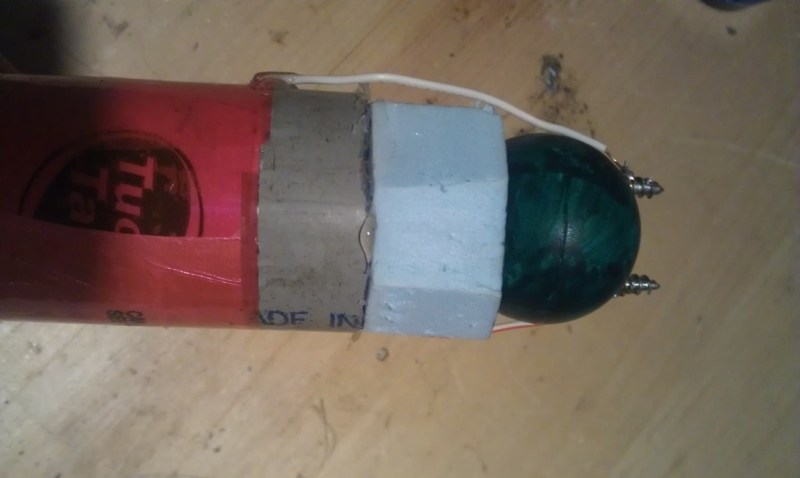[Christopher] has put together a Prank Stun Baton to annoy his friends. It delivers a slight shock to the person on the business end of the device. Oddly, it’s powered solely by static electricity, there is no battery here and the resulting injury is no worse than touching a door knob after scooting your socks around on some shag carpet.
The design is super simple and is effectively just a rudimentary capacitor. The main housing is a PVC pipe that acts as a dielectric in the ‘cap’ system. Two separate pieces of tin foil are wrapped around the inside and outside of the PVC pipe. These layers of tin foil provide a conductive path up to the a couple of screws stuck in the end of the baton. A ping-pong ball and some foam act as an insulator between the PVC and the screws.
To charge the baton it only has to be brought close to a source of static electricity, a tube TV will do the trick. Rubbing it with a piece of wool will also work. When this is done an electrostatic field is stored in the PVC between the two pieces of tin foil, one side takes on a positive charge and the other a negative charge creating an electric potential between the two screws at the end of the baton. When something (with a low-enough resistance) shorts the screws, the stored energy on the positive screw tries to go to the negative screw, shocking the unsuspecting victim.
Need something a little more powerful? You may want to check out this other stun baton.
















so hand held Leyden jar neat and for an idea for version two try sanding the screws a little to be less … poky lol
oddly enough electrons are negative, and flow from “-” to “+”
i might be a loon, but that is my understanding of how it works
Thanks for sending me down the rabbit hole, quite an interesting discussion here https://physics.stackexchange.com/questions/17109/why-is-the-charge-naming-convention-wrong
From what surmised electrons flow from – to + in metals, as you say.
This makes me ask, when connecting to terminals, is it proper to connect ‘-‘ first as I have been taught? I used to do this thinking to first eliminate the cable with no charge; now I wonder if it is proper for another reason.
You are absolutely correct that ELECTRONS flow from a negatively charged source to a positively charged one. However, the electrical CHARGE flows in the opposite direction, from positive to negative (At least with a DC source)….going down that rabbit hole again!
‘Conventional Current’ or ‘electric charge’ is flowing that way, but 99.999% that has no physical context. It’s just a convention produced when we didn’t know what was actually happening. It’s less of a rabbit hole and more of an outdated but difficult to fix piece of notation.
The only time there is any physical reality to ‘moving positive charges’ is when you’ve got an ionized fluid, in which case you -might- have positively charged atoms drifting around.
I believe connecting negative doesn’t have anything with actual polarity, but it’s due to the fact that negative being the ground is connected to some sort of chassis or metallic structure in most applications making it safe for you and the electrical circuits if you connect the ground first. Also most circuits get switched on the positive wiring.
Oh yeah. Should be fun poking your hacker-space buddy right when he’s fiddling with expensive ESD-critical hardware :-)
Or you could just use a high voltage fly swatter…
Those can pack quite a punch, I got a good zap from one of those a few inches from the screen and wearing some type of (non-specialty) gloves.
The funniest part of it is we were trying to convince the new employee to stick his hand in as an initiation- I was either trying to point at it or come close enough to let him think it was safe. Oddly enough he still wanted to stick his hand in..
I had a heck of a shock from one of those. Someone had broken off the swatter and I was left with a handle that had two fine wires. I thought I had discharged it by shorting the wires on a metal surface. So I was futzing with the wires, trying to straighten them for a demonstration. Well, one wire was disconnected, and my shorting of the wires had not de-engergized the stored charge. As I held one wire in each hand, smoothing, the broken wire completed the circuit and I got it through the arms and across my chest. It was a big one! Coulda been a heart stopper, perhaps.
I burned out a cheap DVM trying to measure the voltage from one of those. My first measurement went just fine – I connected the leads before energizing the circuit. But when I tested another swatter, it was already energized and the spike fried the DVM.
Dex has it right, file down those tips, they could hurt worse than the shock. Also could I charge this off of a balloon rubbed on my hair (remember that)?
No! sharpen them up! The ghost of Phillip K. Dick wants you to use it as a vug-stick! Remember – “We are entirely surrounded by vugs!”
Just enough shock and sharp stuff to land you with a Prank Black Eye or Prank Assault Charge….
I recall that holding a metal pen clasp and giving someone a static shock with that, rather than a finger, produced a more painful shock. I woulkd guess that the better conductivity increased the rate of energy delivery.
“a tube TV”, ha ha.
is that another name for a smart tv?